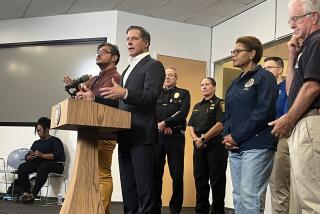Reasons for Opposing Year-Round Schooling
- Share via
As a Latino, as the father of a third-grader attending a Los Angeles school, and as a bilingual kindergarten teacher working for the Los Angeles Unified School District, I have many reasons for opposing year-round schools. Under present circumstances, implementing year-round schools districtwide would institutionalize inferior education, and perpetuate inequality for minority students.
Test scores already indicate that the Los Angeles schools have much catching up to do. For minorities, the statistics are even more depressing. Fifty-two percent of Latinos never even make to 12th grade. Placing the schools on year-round is one option that might alleviate the housing problem, but at what cost academically? If educational environment has anything to do with academic performance, and research says that it does, with multi-track year-round schools we can expect even lower performances.
The 93 Latino schools that were the year-round guinea pigs five years ago have not shown any marked academic improvement. And their scores were already low.
When the Board of Education held hearings in December, black, Latino and Asian parents who have children in these schools voiced their opposition to year-round school. It’s fair to assume that these parents who have taken time out to attend evening board meetings are the most involved and most knowledgeable of the situation at their particular schools.
Up until last year I taught at a year-round school for five years. What I remember most from that experience was chaos and interruptions. All teachers had to share classrooms with the roving classes. Roving teachers had no classrooms of their own and had to transport all their materials in small carts. In kindergarten, where a quality educational environment should be most important, up to four classes, 120 students total, were rotated into one classroom. Teaching and learning is difficult the first week on track because teachers are unpacking materials and students are still “high” from their vacations. Teaching and learning is difficult during the last week on track because teachers are busy packing up materials and students are anticipating their vacations. Students forget subject matter during their three- and four-week vacations. Some students even forget to return to school. Under some year-round schedules the instructional day is made longer because students attend less days per year. Teachers are expected to plan for this longer day, given only half an hour planning before and after school.
The concept of year-round school could be supported if it meant that students would actually attend school for more days, meaning that they’d be receiving more instructional time; it could be supported if students and teachers could have their own classrooms; if teachers were given planning time. Unfortunately, the motivation for year-round’s implementation has not been quality education. Instead, we approach education only in terms of numbers, sort of a factory mentality.
The public and our educational leaders must come to terms with the fact that quality education costs money. In this case the money it will take to build more schools. Institutionalizing year-round schools in Los Angeles can only lower educational standards that are already at an all time low.
JOHN ESPINOZA
Los Angeles
More to Read
Sign up for Essential California
The most important California stories and recommendations in your inbox every morning.
You may occasionally receive promotional content from the Los Angeles Times.













